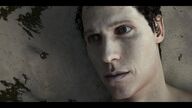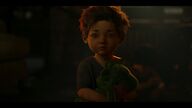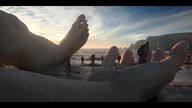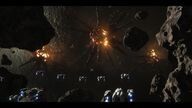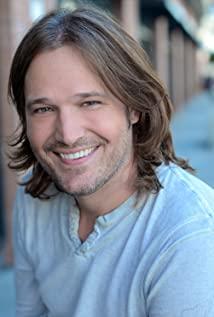They are all saying that 14 is wonderful, because the topics are easy to understand and philosophical, or 3 is wonderful, because it is the peak of art in the whole season...
The seventh episode is actually the most interesting and in-depth episode of the entire season, and the most interesting thing is that the audience also becomes a part of the story - definitely intentional by the director.
"The Interracial Mercy of Alien Spiders" seems to be the mainstream "correct solution" for this episode, which is also the deepest part of this episode. Yes, the director is making the audience be the real Captain Tom. Throughout the whole story, to cater to the emotions rendered by the insertion song, this interpretation seems to have no problem, but if you look for clues from the beginning, you will find that this is the beautiful and false dream woven by the director (spider) for the audience (Tom):
From the very beginning, the black man said that the coordinates were off, and then Susie found a "shortcut" to save money in the star map (apparently she hadn't taken it before), and this road was the road to the spider web. The spider's lair appears in the star map navigation, so is it a bug in the star map system or "fishing" like the modern Internet? We only know that the director deliberately released the star map at the beginning, and has clearly told us that the routing system of the dispatch station was absolutely wrong [not mentioned by the spider queen later]. When Susie was [choosing her own route], no matter what, The journey is doomed to be a point of no return.
Then they fell into a spider web and entered the virtual space station. Greta told them that they had deviated from the course because of Lu You's mistake. [The spider's lair appears in the star map, which is the "shortcut" that Susie voluntarily chose. It is obvious that this is a lie. ] Susie's skeptical attitude is subconscious resistance. There should be no objection to any interpretation here, and Susie's dizziness after the first time out of the warehouse can be understood as the suppression of the spirit of resistance by the virtual environment created by the spider queen. The scales also tend to believe that reality is in front of you. Then the interlude sounded, and quickly entered the climax of this episode. Under the cracks of dreams, sex, fine wine - the joys that human beings can't resist and are engraved at the bottom of their genes. There are actually three icons in question here: sex and wine, and then you will be greeted by death. There is a small detail in this paragraph. When the two are sitting on the sofa, Greta in the wine glass is the image of a spider.
Then came the confession of the sage time, [due to the routing error (dispatching station)] came to a farther place than expected, which made Tom trust the spider queen more, and also made the audience more willing to believe in the mainstream correct solution "alien race" A merciful consolation to the lost." This sweet dream. At this point, the spider queen felt that maybe the subconscious resistance was controllable, and recommended Tom to try to wake up his friends again. (Why this is interpreted here will be explained later.)
After being awakened, Susie was more resistant than expected, and she suspected and attacked Greta without any basis (so that the first time I saw this paragraph was a bit inexplicable), Greta had no choice but to use a sedative-pressing Awareness of resistance. After that, Tom still noticed the strangeness, and the anger made the virtual world become unstable. At this time, the queen decided to play a tragic scene (what do you mean by revealing the truth? It is not difficult, the film is motion capture, played by people, not to mention the background is set to This is a high-level life with predation? Besides, it's all virtual? Of course, you can continue to think it's the truth, which is part of the director's hope.), and then take advantage of the cruel reality to let Tom take the initiative to accept the illusion, and at the same time the audience It is also falling into the trap of "cross-racial feelings". In the real scene, it can be found that, including the protagonist's spaceship, there are a lot of broken spaceship wreckage wrapped in spider webs. The habitat of the spider queen. The protagonist and his party are already skinny, and two people except Tom are dead. Here you can think about the way spiders hunt: pulling the web, sticking to the prey, entangling it with spider silk, injecting toxins into the prey to decompose the interior into liquid and sucking it dry. Is it similar to the way the protagonist and his party died? There is another small detail in this paragraph. Before walking out of the shadows, the spider queen is looming, giving the illusion of a woman's nudity, and the moment when she walks out of the light, the really ferocious spider monster seems to tell the audience [Although I look ugly and scary, I am like a human being. It also has the same kind heart], which once again brought the audience's goodwill towards the Spider Queen, and was pulled into a sweet and false dream by the director step by step.
In the end, Tom couldn't accept the cruel and horrifying reality, so he took the initiative to accept the virtual world, and the camera looked down, representing Susie who resisted, and her balance chamber was sealed with a [biohazard sign] (this is why the above is interpreted as such). The music played again, and finally the camera pulled to the outside of the space station, the huge spider nest, and the wreckage of several spacecraft entangled in spider silk - sex and wine, sweet dreams, sweet deaths.
On the grounds of concern, the Spider Queen drags Tom into a false and sweet dream step by step, and the director of the entire film is also dragging the audience into the "beautiful meaning that they would rather believe in" step by step. Behind the sweet interpretation is also the control of higher creatures over lower creatures - just like the sheep in the sheepfold think that the approaching farmer is kind. This is a tragic story without a trace of beauty at the core, cruel and ruthless.
It's one thing to express the truth, and another thing is the interpretation that the audience is willing to believe. If the audience is willing to blindfold and believe that this is a love story, then he is a love story, just like Tom in a dream, and This part of the "beautiful meaning that I would rather believe in" should also be what the director really expects to exist.
Finally, let me mention this godlike insertion song. The lyrics are very suitable for the theme. Listen carefully to the last few lines at the end of the credits: Who's the enemy? Don't know what to believe, Living in the shadows. Living in the shadows.
View more about Love, Death & Robots reviews



